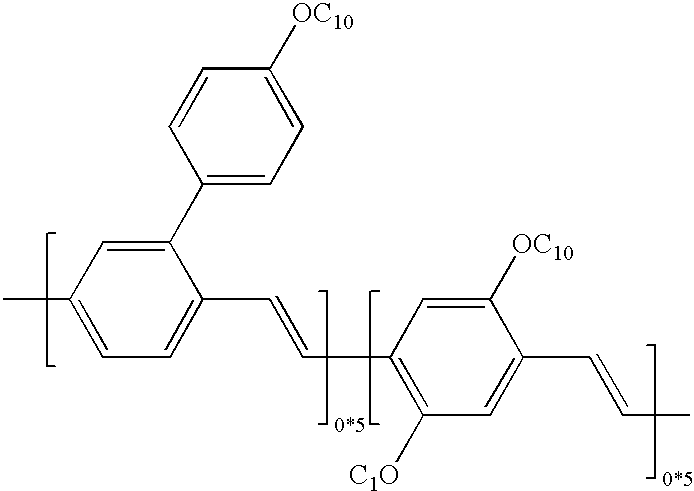Led comprising a conductive transparent polymer layer with low sulfate and high metal ion content
a polymer layer and transparent polymer technology, applied in the direction of non-metal conductors, conductors, thermoelectric devices, etc., can solve the problems complex and expensive methods of making layers with conductive and non-conductive areas, and pixels, which are electrically connected via ctp layers, suffer from shrinkage under multipled driving, etc., to achieve the effect of reducing the performance of leds, preventing substantial absorption of visible light, and essentially
- Summary
- Abstract
- Description
- Claims
- Application Information
AI Technical Summary
Benefits of technology
Problems solved by technology
Method used
Image
Examples
example 2
Example 1 was repeated, except that different concentrations of sulfate ions were added to the PEDOT dispersion. To demonstrate that SO.sub.4.sup.2- ions are detrimental to lifetime and efficiency of a polyLED, sulfuric acid (H.sub.2 SO.sub.4) was added to PEDOT:
A 100 ml of the PEDOT dispersion of Example 1 has a 4 wt. % solid content, of which about 95 wt. % is PSS. This corresponds to 0.021 mole monomer of PSS in 100 ml of PEDOT.
Respectively, 0.001 mole (=0.096 g=960 ppm SO.sub.4.sup.2- per 100 ml) and 0.005 moles (=0.48 g=4800 ppm SO.sub.4.sup.2- per 100 ml) of H.sub.2 SO.sub.4 were added to the PEDOT dispersion. The efficiency and lifetime of the devices decreased dramatically as shown in Table 2.
Metal ion sulfates, such as K.sub.2 SO.sub.4, added to the PEDOT dispersion had the same detrimental effect as H.sub.2 SO.sub.4.
Table 2. Efficiency at room temperature and lifetime under DC driving of the light emitting polymer at 80.degree. C., 200 cd / m.sup.2 with standard and modified...
example 3
Example 1 was repeated, except that NaCl was added to the PEDOT dispersion to prevent anode shrinkage as presented in FIG. 4, to give 0.022 mmoles / g of sodium in the dispersion. The material as used in Example 1 showed an inhomogeneous electroluminescence in four rows of pixels already after 24 h at 80.degree. C. under multiplexed driving, whereas the matrix display in addition containing 0.022 mmoles / g of sodium did not give anode shrinkage after 24 h.
example 4
Example 1 was repeated, except that NaCl was added to the PEDOT dispersion to give 0.088 mmoles / g of sodium in the dispersion. After 96 h service lifetime test under a multiplexed driving scheme, the matrix display showed no anode shrinkage.
The examples hereinabove illustrate that the amount of sodium in a charge transport polymer (CTP) layer for use in an organic LED may have a significant effect on the extent of anode shrinkage observed in accelerated service life tests in which the LED is driven in a multiplexed driving scheme. The light emitting polymer used is these examples is a PPV.
Similar results are obtained for polyfluorenes as light emitting polymer. In a specific example of a LED comprising a red emitting polyfluorene and a CTP layer comprising about 0.25 mmol / g Na, no anode shrinkage is observed in a lifetime test performed at 80.degree. C. for 600 h. By comparison, if the same CTP layer is used but without sodium severe anode shrinkage is observed. Identical results ar...
PUM
| Property | Measurement | Unit |
|---|---|---|
| thickness | aaaaa | aaaaa |
| thickness | aaaaa | aaaaa |
| thickness | aaaaa | aaaaa |
Abstract
Description
Claims
Application Information
 Login to View More
Login to View More - R&D
- Intellectual Property
- Life Sciences
- Materials
- Tech Scout
- Unparalleled Data Quality
- Higher Quality Content
- 60% Fewer Hallucinations
Browse by: Latest US Patents, China's latest patents, Technical Efficacy Thesaurus, Application Domain, Technology Topic, Popular Technical Reports.
© 2025 PatSnap. All rights reserved.Legal|Privacy policy|Modern Slavery Act Transparency Statement|Sitemap|About US| Contact US: help@patsnap.com



